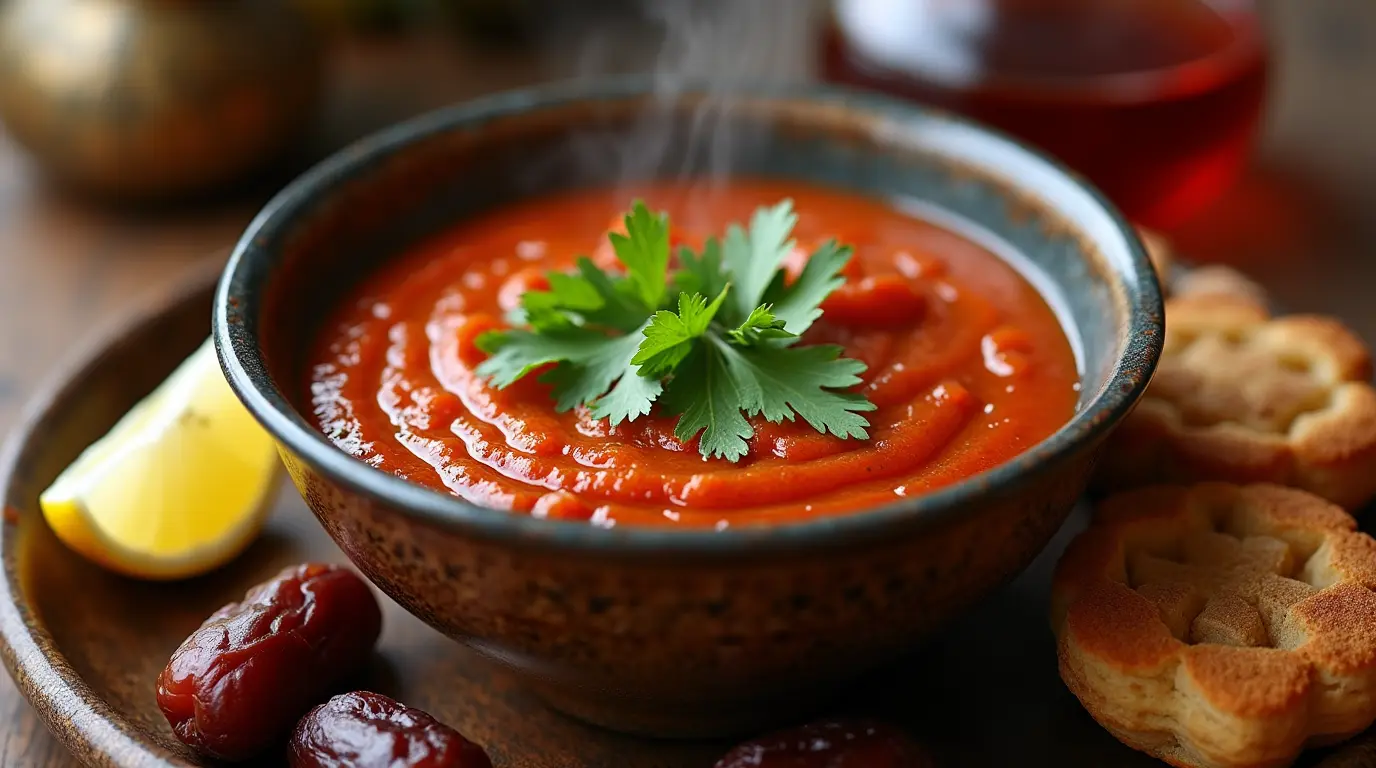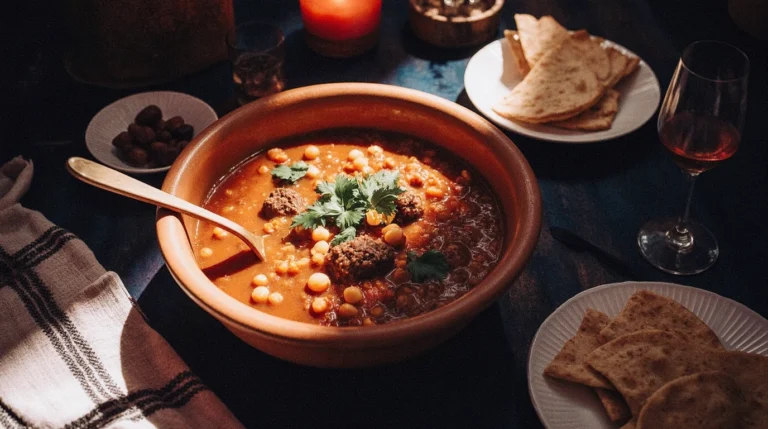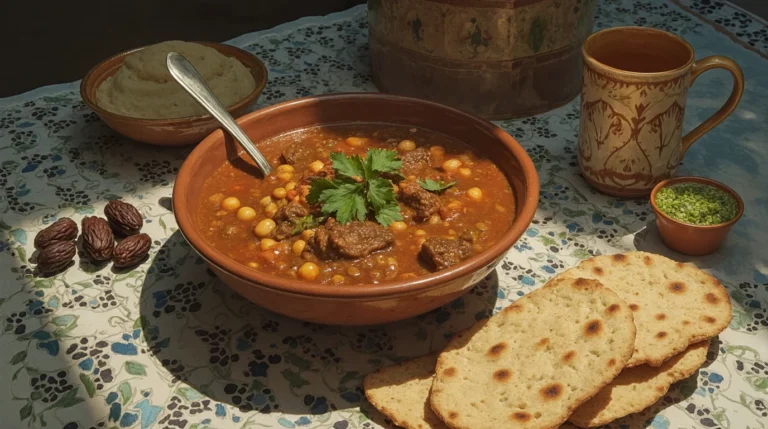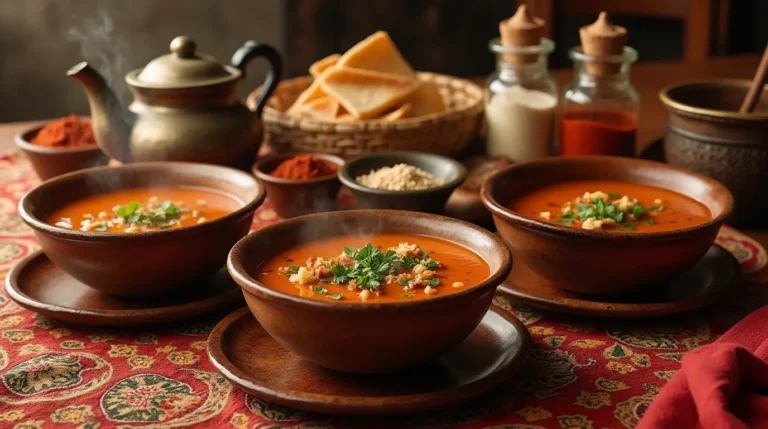10 Traditional Moroccan Soups and Stews You Must Try
Morocco—a land where spices perfume the air and culinary traditions stretch back centuries. If you’re a soup and stews enthusiast looking to expand your repertoire, Moroccan cuisine offers some of the most flavorful, comforting bowls you’ll ever taste. These dishes aren’t just meals; they’re cultural experiences that tell the story of Morocco’s rich heritage and diverse influences.
Let’s explore ten traditional Moroccan soups and stews that will transport your taste buds to the bustling souks and serene riads of this North African culinary paradise.
1. Harira: The Ramadan Essential – Soups and Stews
Harira isn’t just a soup—it’s a cornerstone of Moroccan culture. This hearty tomato-based soup becomes especially important during Ramadan, when it traditionally breaks the daily fast.
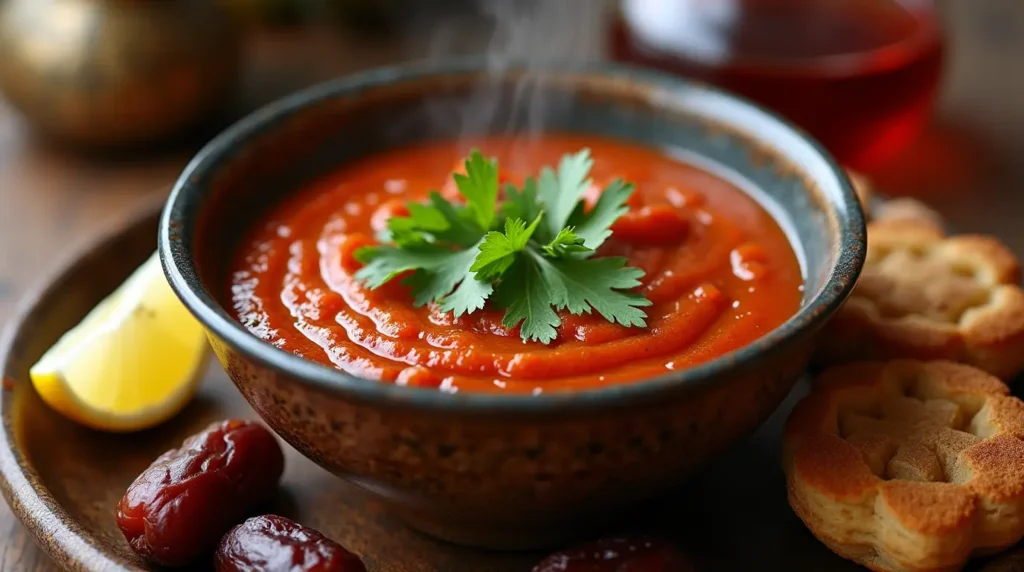
How to Make Authentic Harira:
- Gather your ingredients: You’ll need diced lamb or beef, lentils, chickpeas, tomatoes, onions, celery, fresh herbs (cilantro and parsley), flour, and a beautiful blend of spices including cinnamon, ginger, turmeric, and pepper.
- Prepare your base: Begin by sautéing diced onions in olive oil until translucent. Add your meat and brown it lightly.
- Build the flavor: Add your spices—typically 1 teaspoon each of turmeric, cinnamon, ginger, and black pepper—and stir until fragrant. This creates the aromatic foundation that makes harira so distinctive.
- Create the body: Add diced tomatoes, lentils, and chickpeas (pre-soaked if using dried). Pour in about 8 cups of water or stock and bring to a simmer.
- Let time work its magic: Allow your harira to simmer for at least an hour, letting the flavors meld and the meat become tender.
- Thicken and finish: In the last 15 minutes, mix a tablespoon of flour with water to create a slurry and stir it in to thicken the soup. Add fresh chopped herbs and a squeeze of lemon juice.
- Serve with tradition: Harira is typically accompanied by dates and chebakia (honey-coated sesame cookies) during Ramadan, but crusty bread works beautifully any time of year.
This soup strikes a perfect balance between hearty and refreshing, making it suitable for any season despite its Ramadan associations.
2. Bissara: The Humble Fava Bean Soup – Soups and Stews
Bissara represents the beautiful simplicity of Moroccan country cooking. This creamy fava bean soup originated in northern Morocco and has been sustaining farmers and workers for generations.
Creating Your Own Bissara:
- Start with dried split fava beans: Soak approximately 2 cups overnight for the best texture.
- Create your flavor base: Sauté diced onions and garlic in olive oil until soft and fragrant.
- Simmer to perfection: Add your drained fava beans and cover with water. Add cumin, paprika, and bay leaves, then simmer for about 45 minutes until the beans are completely soft.
- Blend for creaminess: Use an immersion blender to create a smooth, velvety texture. Adjust the consistency with more water if needed.
- Garnish generously: The toppings make bissara special! Drizzle with good quality olive oil, sprinkle with cumin, and add a touch of spicy paprika.
- Serve hot: Bissara is traditionally enjoyed for breakfast with fresh bread for dipping, but it makes a satisfying light meal any time of day.
What makes bissara special is its surprising depth of flavor despite the short ingredient list. It’s proof that humble ingredients, when treated with respect, can create extraordinary meals.
3. Chorba: The Berber Vegetable Soup – Soups and Stews
Chorba exemplifies the Berber influence in Moroccan cuisine. This hearty vegetable soup varies from region to region but always delivers rustic comfort.
Making Authentic Chorba:
- Start with aromatics: Sauté chopped onions, celery, and garlic in olive oil until softened.
- Add your vegetables: Traditional chorba includes carrots, turnips, zucchini, and potatoes, all cut into similar-sized pieces for even cooking.
- Incorporate grains: Most versions include either rice, broken vermicelli pasta, or barley for substance.
- Season thoughtfully: Add traditional spices like turmeric, ginger, cinnamon, and the vital ras el hanout blend that gives chorba its distinctive flavor.
- Simmer slowly: Allow all ingredients to cook together for at least 30 minutes, letting the flavors meld completely.
- Finish with freshness: Just before serving, stir in abundant fresh herbs—cilantro and parsley are traditional—and a squeeze of lemon juice to brighten the flavors.
- Serve alongside bread: Moroccan khobz (bread) is perfect for soaking up the flavorful broth.
What’s wonderful about chorba is its adaptability. While maintaining its essential character, you can adjust the vegetables based on seasonal availability, making it a year-round staple.
4. Tangia: The Bachelor’s Stew – Soups and Stews
Unlike most Moroccan dishes prepared by women, tangia has historically been the domain of men—particularly bachelors in Marrakech. Named after the earthenware pot it’s cooked in, this slow-cooked lamb stew showcases the beauty of patience in cooking.
Creating Authentic Tangia:
- Select quality ingredients: Start with 2 pounds of lamb shoulder cut into large chunks. The relatively high fat content is perfect for long cooking.
- Keep seasonings simple but potent: Combine preserved lemon, garlic cloves, cumin, saffron threads, and ample olive oil with your meat.
- Embrace traditional cooking: Traditionally, tangia is wrapped in parchment and slow-cooked in the dying embers of hammam (bathhouse) fires. At home, recreate this by cooking at a very low temperature (275°F/135°C) in a covered clay pot or Dutch oven.
- Practice patience: True tangia requires at least 6-8 hours of cooking, during which time the meat becomes incredibly tender and the flavors intensify.
- Serve with minimal garnish: Unlike many Moroccan dishes, tangia needs little embellishment. A sprinkle of fresh parsley and some bread for soaking up the juices is all you need.
The magic of tangia lies in its simplicity and the transformation that happens during the long, slow cook. The meat becomes so tender it practically dissolves, while the preserved lemon provides a distinctive tangy contrast.
5. Tagine with Green Olives and Preserved Lemon – Soups and Stews
While technically a stew rather than a soup, no discussion of Moroccan one-pot cooking would be complete without mentioning tagine. The chicken tagine with green olives and preserved lemon is perhaps the most iconic version.
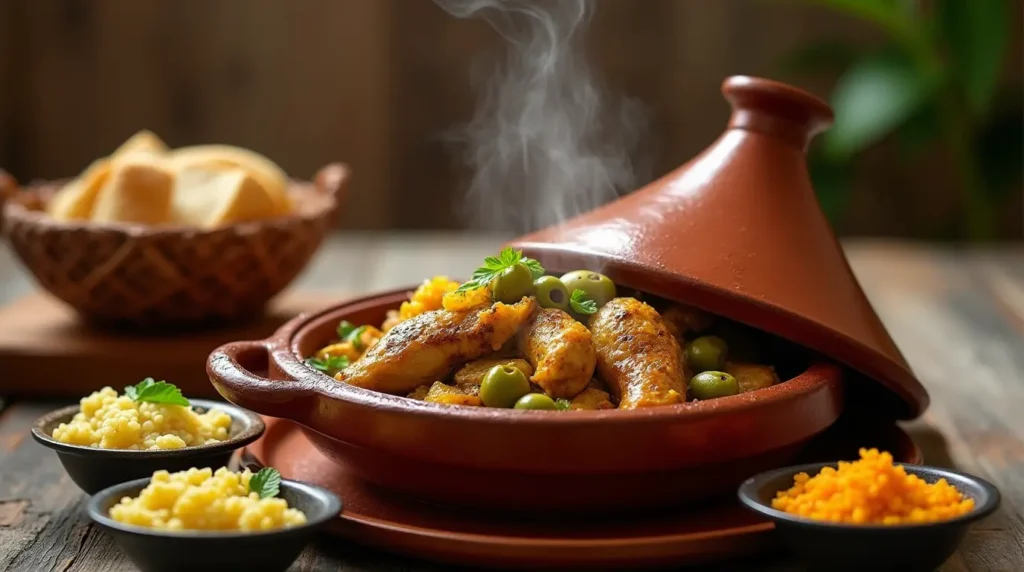
Creating This Classic Tagine:
- Start with marination: Rub chicken pieces with garlic, ginger, turmeric, saffron, and olive oil, then refrigerate for at least an hour (overnight is better).
- Layer your ingredients: In a traditional conical tagine pot or heavy Dutch oven, create a bed of sliced onions, then arrange the marinated chicken on top.
- Add your signature ingredients: Scatter quartered preserved lemons and green olives around the chicken pieces.
- Create the sauce: Pour in chicken stock or water with a little olive oil, then sprinkle with additional spices like cinnamon and black pepper.
- Cook low and slow: Cover and simmer over low heat for approximately 90 minutes. The conical shape of a traditional tagine pot returns condensation to the dish, creating a self-basting environment.
- Finish with herbs: Just before serving, sprinkle with chopped cilantro or parsley.
- Serve family-style: Tagines are traditionally brought to the table in their cooking vessel and shared communally.
The combination of preserved lemon’s brightness and the brininess of olives creates an unforgettable flavor profile that’s distinctively Moroccan.
6. Mrouzia: The Sweet and Savory Festival Stew – Soups and Stews
Mrouzia is a festive lamb stew traditionally prepared for Eid al-Adha. Its distinctive sweet-savory profile comes from honey and dried fruits balanced with aromatic spices.
Creating Mrouzia for Special Occasions:
- Begin with the meat: Brown lamb pieces (traditionally shoulder or neck) in olive oil until well-caramelized.
- Add depth with spices: Incorporate a generous amount of ras el hanout (at least 2 tablespoons for 2 pounds of meat), along with ginger, cinnamon, saffron, and pepper.
- Balance with sweetness: Add honey (about 3 tablespoons) and a handful each of raisins and dried apricots.
- Include the secret ingredient: Ras el hanout often contains “grains of paradise,” but if you can’t find this spice, black pepper with a touch of cardamom makes a suitable substitute.
- Patience is key: Simmer very gently for at least 2-3 hours until the meat is falling-apart tender and the sauce has thickened substantially.
- Garnish appropriately: Finish with toasted almonds or sesame seeds for texture contrast.
- Serve with respect for tradition: Mrouzia is traditionally accompanied by couscous and served from a communal dish.
What makes mrouzia special is its ability to balance seemingly contradictory flavors—sweet honey and fruits alongside savory meat and aromatic spices—creating a harmonious dish that reflects the complexity of Moroccan cuisine.
7. Berkoukes: The Magical Pasta Stew – Soups and Stews
Berkoukes demonstrates the influence of Berber traditions on Moroccan cuisine. This hearty stew combines handmade pasta pearls with vegetables and meat for a complete one-pot meal.
Making Traditional Berkoukes:
- Prepare the pasta (if making from scratch): Form a stiff dough from semolina flour and water, then roll small pieces between your palms to create tiny pasta pearls similar to large couscous.
- Create your stew base: Brown chunks of lamb or chicken with onions, then add garlic, tomatoes, and spices including cumin, paprika, and coriander.
- Add substance with vegetables: Incorporate carrots, turnips, chickpeas, and whatever seasonal vegetables you have available.
- Build the broth: Add enough stock or water to cover, then simmer until the meat is nearly tender (about 45 minutes).
- Integrate the pasta: Add your berkoukes pasta pearls (or substitute Israeli couscous if needed) and continue cooking until the pasta is tender, about 15-20 minutes.
- Adjust seasonings: The dish should have a relatively thick consistency and well-developed broth.
- Serve communally: Like many Moroccan dishes, berkoukes is traditionally served from a central dish for family-style eating.
What makes berkoukes special is the textural contrast between the tender meat, vegetables, and the slightly chewy pasta pearls that absorb the rich flavors of the broth.
8. Rfissa: The Celebratory Chicken Stew – Soups and Stews
Rfissa holds special significance in Moroccan culture, traditionally served to new mothers to help restore strength. This unique dish combines shredded msemen (flaky flatbread) with a richly spiced chicken stew.
Creating Ceremonial Rfissa:
- Prepare your spice mixture: Begin by toasting fenugreek seeds, which give rfissa its distinctive flavor, along with other spices like cinnamon, ginger, turmeric, and ras el hanout.
- Cook the chicken: Simmer chicken pieces with lentils, onions, and your spice mixture until the meat is falling off the bone.
- Prepare the msemen base: Either make traditional msemen flatbread or substitute with torn crepes or tortillas. Layer in a large serving dish.
- Assemble the dish: Pour the hot chicken stew over the shredded bread, allowing it to soak up the flavorful sauce.
- Garnish traditionally: Add caramelized onions, a sprinkle of fenugreek seeds, and fresh herbs.
- Allow time for melding: Let the dish rest for about 10 minutes before serving, allowing the bread to absorb the broth without becoming soggy.
- Serve with respect: Given its traditional role as a recuperative food, rfissa deserves to be presented with particular care.
The magic of rfissa lies in the bread soaking up the intensely flavored broth, creating a dish that’s somewhere between a stew and a savory bread pudding—uniquely satisfying and nourishing.
9. Loubia: The Humble White Bean Stew – Soups and Stews
Loubia exemplifies how Moroccan cuisine can transform simple ingredients into extraordinary meals. This white bean stew is a staple in many households, particularly during cooler months.
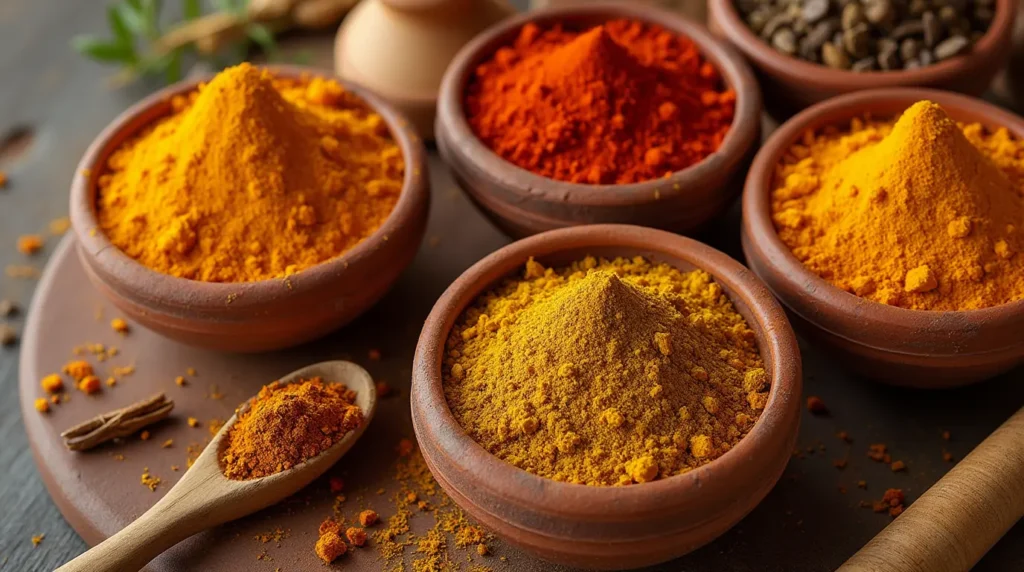
Creating Comforting Loubia:
- Begin with dried beans: Soak white beans (usually navy or cannellini) overnight for the best texture.
- Build your flavor base: Sauté diced onions and garlic in olive oil, then add diced tomatoes and tomato paste.
- Incorporate key spices: Add paprika, cumin, and a bay leaf, which provide loubia its distinctive Moroccan character.
- Cook with patience: Simmer the beans in the seasoned liquid until tender but not mushy, typically 60-90 minutes.
- Season thoughtfully: Unlike some Moroccan dishes, loubia relies on a relatively simple spice profile, allowing the beans’ natural creaminess to shine.
- Finish with freshness: Just before serving, add chopped parsley and a drizzle of good olive oil.
- Serve with bread: Loubia is traditionally enjoyed with chunks of crusty bread for dipping.
What makes loubia special is its ability to showcase how Moroccan cuisine can elevate even the humblest ingredients into something deeply satisfying and flavorful.
10. M’roud: The Desert Stew – Soups and Stews
M’roud represents the ingenuity of desert cooking. This stew from southern Morocco uses preserved meat to create a hearty meal even when fresh ingredients are scarce.
Creating Authentic M’roud:
- Start with preserved meat: Traditionally made with gueddid (sun-dried strips of seasoned meat), but you can substitute with heavily seasoned beef that’s been slowly dried in a low oven.
- Rehydrate with purpose: Soak the preserved meat in water with aromatic spices like cinnamon and cloves to soften it and remove excess salt.
- Create your base: Sauté onions until deeply caramelized, then add garlic, ginger, and spices including saffron and black pepper.
- Incorporate signature ingredients: Add dates and sometimes apricots for sweetness that balances the intensely savory meat.
- Simmer with intention: Cook slowly until the meat is tender and the flavors have fully developed, at least 2 hours.
- Adjust to taste: The balance of sweet and savory should be distinctive but harmonious.
- Serve traditionally: M’roud is typically accompanied by simple bread or couscous to absorb its complex flavors.
M’roud tells the story of survival and adaptation in harsh desert conditions, where preservation techniques transformed necessity into culinary art.
Conclusion
These ten traditional Moroccan soups and stews offer more than just nourishment—they provide a window into a culture where food is an expression of hospitality, history, and community. From the ritual significance of Ramadan’s harira to the celebratory nature of rfissa, each dish carries meaning beyond its ingredients.
By bringing these recipes into your kitchen, you’re not just expanding your culinary repertoire; you’re participating in traditions that have been passed down through generations of Moroccan families. So gather your spices, prepare your ingredients, and embark on a flavorful journey through one of the world’s most exciting cuisines.
Whether you’re seeking comfort on a cold day, nourishment when feeling under the weather, or simply an exciting new addition to your cooking repertoire, these Moroccan soups and stews deliver satisfaction in every spoonful. Enjoy the journey, and as they say in Morocco, “Bssaha!”—to your health!

